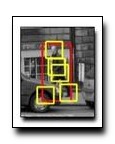
This paper describes a discriminatively trained, multiscale,
deformable part model for object detection. Our system
achieves a two-fold improvement in average precision
over the best performance in the 2006 PASCAL person detection
challenge. It also outperforms the best results in the
2007 challenge in ten out of twenty categories. The system
relies heavily on deformable parts. While deformable part
models have become quite popular, their value had not been
demonstrated on difficult benchmarks such as the PASCAL
challenge. Our system also relies heavily on new methods
for discriminative training. We combine a margin-sensitive
approach for data mining hard negative examples with a
formalism we call latent SVM. A latent SVM, like a hidden
CRF, leads to a non-convex training problem. However,
a latent SVM is semi-convex and the training problem
becomes convex once latent information is specified for
the positive examples. We believe that our training methods
will eventually make possible the effective use of more
latent information such as hierarchical (grammar) models
and models involving latent three dimensional pose.
Download: pdf
Text Reference
Pedro Felzenszwalb, David McAllester, and Deva Ramanan.
A discriminatively trained, multiscale, deformable part model.
In
IEEE Conference on Computer Vision and Pattern Recognition (CVPR). 2008.
BibTeX Reference
@inproceedings{FelzenszwalbMR_CVPR_2008,
author = "Felzenszwalb, Pedro and McAllester, David and Ramanan, Deva",
booktitle = "IEEE Conference on Computer Vision and Pattern Recognition (CVPR)",
title = "A Discriminatively Trained, Multiscale, Deformable Part Model",
year = "2008",
tag = "object_recognition"
}
